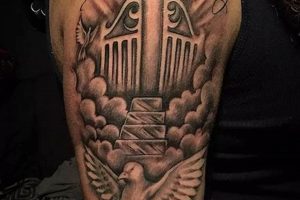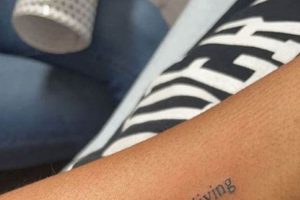Tattoos inspired by ancient Egypt encompass a wide range of imagery, from powerful deities and hieroglyphs to symbolic animals and geometric patterns. Examples include depictions of Anubis, the god of the afterlife, or the Eye of Horus, a symbol of protection. These designs often incorporate vibrant colors and intricate details, reflecting the rich artistic traditions of ancient Egyptian culture.
The enduring appeal of this style lies in its connection to a civilization known for its mythology, spirituality, and artistic sophistication. These designs can represent a personal connection to ancient Egyptian history, an appreciation for its artistic legacy, or the symbolic meaning embedded within the chosen imagery. The rich symbolism offers individuals the opportunity to express complex ideas and beliefs through body art, adding a layer of personal significance beyond mere aesthetics.
Exploring specific design elements, understanding their historical context, and considering placement on the body are all crucial steps in choosing a meaningful and visually appealing design. Further examination of popular motifs, color palettes, and the evolution of these designs in contemporary tattooing will provide a deeper understanding of this captivating art form.
1. Deities (Ra, Anubis, Isis)
Egyptian deities play a central role in tattoo designs, offering powerful symbolism and a connection to ancient mythology. Ra, the sun god, represents light, warmth, and life-giving energy. Anubis, the jackal-headed god of the dead, symbolizes guidance and protection in the afterlife. Isis, a powerful goddess of magic and healing, represents motherhood, rebirth, and feminine power. Choosing a deity reflects not only an appreciation for Egyptian mythology but also a personal connection to the specific values and powers embodied by the chosen god or goddess. For instance, a tattoo of Ra might symbolize a focus on positivity and growth, while Anubis might represent overcoming challenges and embracing transformation. Depictions can range from traditional representations found in ancient art to more contemporary interpretations.
The depiction of these deities in tattoos often incorporates specific iconography. Ra is frequently shown with a sun disk atop his head, sometimes adorned with a cobra. Anubis is readily identifiable by his jackal head and often carries an ankh, symbolizing life. Isis is often depicted with large wings or wearing a horned headdress, sometimes holding an ankh or a staff. Understanding these symbolic elements enhances the meaning and depth of the tattoo. The choice of specific elements can further personalize the design, adding layers of significance unique to the individual. Placement on the body can also amplify the symbolism; for example, a tattoo of Ra on the shoulder might symbolize carrying the weight of responsibility with strength and light.
Careful consideration of the deity’s attributes and associated symbolism is essential for creating a meaningful and respectful tattoo. Researching the historical context and significance of these figures ensures an informed choice, avoiding potential misinterpretations or cultural appropriation. Ultimately, incorporating Egyptian deities into tattoo designs provides a powerful way to connect with a rich spiritual tradition and express personal values through visually striking body art.
2. Hieroglyphs (symbols, stories)
Hieroglyphs, the pictorial writing system of ancient Egypt, offer a rich source of inspiration for tattoos. These symbols carry deep cultural and historical significance, allowing individuals to express complex ideas, beliefs, and stories through body art. Understanding the meaning and context of hieroglyphs is crucial for creating a meaningful and respectful tattoo.
- Individual Symbols
Single hieroglyphs can represent a wide range of concepts, from abstract ideas like life, death, and rebirth to concrete objects like the sun, moon, and various animals. For example, the ankh symbolizes life, while the djed represents stability. Incorporating individual symbols allows for concise and powerful expressions of personal values or beliefs.
- Cartouches
Originally used to encircle the names of pharaohs, cartouches provide a visually appealing way to incorporate names or short phrases into a tattoo design. This framing device adds a sense of formality and importance to the enclosed text, whether it’s a personal name, the name of a loved one, or a meaningful word. This allows for a personalized and historically resonant element within the tattoo.
- Phrases and Spells
Hieroglyphs can be combined to form phrases or even spells, allowing for more complex narratives and expressions of personal philosophies. Short blessings, quotes from ancient texts, or personalized mantras can be translated into hieroglyphs, adding a deeper layer of meaning to the tattoo. However, accurate translation and understanding of the chosen text are paramount to avoid misinterpretations.
- Stylized Representations
While traditional hieroglyphic representations offer authenticity, stylized versions allow for artistic freedom and personalization. Modern interpretations can incorporate elements of traditional design while adapting them to individual preferences and aesthetic sensibilities. This allows for a unique expression that resonates with both ancient symbolism and contemporary artistic styles.
From individual symbols to complex narratives, the incorporation of hieroglyphs in tattoo designs offers a powerful means of connecting with ancient Egyptian culture and expressing personal meaning through a visually captivating art form. Careful research and consultation with knowledgeable sources are essential for ensuring accurate representation and cultural sensitivity.
3. Symbolic animals (scarabs, cats)
Animals held profound symbolic meaning in ancient Egyptian culture, frequently appearing in art and religious iconography. Their incorporation into modern tattoo designs continues this tradition, offering a rich tapestry of meaning and visual appeal. Certain animals represent specific concepts, deities, or aspects of the afterlife, adding layers of significance beyond mere aesthetic appreciation.
The scarab beetle, for example, represents rebirth, renewal, and the cyclical nature of life. Its association with the sun god Ra further connects it to themes of creation and life-giving energy. Depictions of scarabs pushing a ball of dung symbolize the sun’s journey across the sky and the continuous cycle of life, death, and resurrection. Consequently, scarab tattoos often represent overcoming challenges, personal transformation, and the pursuit of spiritual growth.
Cats, particularly the domesticated cat, held a special place in ancient Egyptian society, often associated with the goddess Bastet. Bastet, depicted with a cat’s head, represents protection, fertility, and motherhood. Cats were revered for their grace, independence, and hunting prowess. In tattoo designs, cats can symbolize femininity, intuition, mystery, and a connection to the divine feminine. Specific depictions, such as a cat sitting upright with an ankh, can further enhance the symbolic meaning, adding layers of personal significance.
Other animals, such as the falcon (representing Horus, the god of the sky), the ibis (associated with Thoth, the god of wisdom and writing), and the snake (representing protection and royalty), also feature prominently in Egyptian-inspired tattoos. The choice of animal and its specific depiction can convey a wide range of meanings, allowing individuals to express complex ideas and personal connections to ancient Egyptian symbolism. Careful research into the historical and cultural significance of these animals ensures a respectful and meaningful tattoo design.
Understanding the symbolic weight these animals carry allows for a more informed choice, enriching the tattoo’s personal significance. This knowledge not only enhances the aesthetic value but also deepens the connection between the individual and the rich cultural heritage of ancient Egypt. Thoughtful placement and artistic style further contribute to the overall impact and personal expression conveyed by the tattoo.
4. Geometric patterns (strength, balance)
Geometric patterns played a significant role in ancient Egyptian art and architecture, representing concepts of order, stability, and cosmic balance. Their integration into tattoo designs continues this tradition, offering visually compelling expressions of these fundamental principles. Specific patterns hold symbolic meaning, often connected to mathematical principles revered by the ancient Egyptians. These patterns can represent strength, resilience, and the interconnectedness of all things.
One prominent example is the repeating pattern of interlocking triangles, sometimes referred to as the “Isis knot” or “tyet.” This pattern symbolizes the goddess Isis and represents the concepts of life, fertility, and protection. Another frequently used motif is the square, representing stability and foundation. Concentric circles symbolize the cyclical nature of time and the interconnectedness of the cosmos. Furthermore, incorporating geometric patterns alongside other Egyptian motifs, such as deities or hieroglyphs, can enhance the overall symbolic meaning of the tattoo.
The use of geometric patterns in Egyptian tattoo designs provides a powerful way to connect with ancient wisdom and express abstract concepts visually. Understanding the historical and cultural context of these patterns enhances their significance, ensuring a respectful and meaningful representation. Furthermore, the clean lines and symmetrical nature of geometric designs lend themselves well to various tattoo styles and placements, offering a versatile option for individuals seeking both aesthetic appeal and symbolic depth. The continued popularity of these designs demonstrates their enduring appeal and relevance in contemporary body art.
5. Placement and Sizing
Placement and sizing are crucial considerations in Egyptian tattoo design, impacting both the aesthetic balance and the symbolic meaning. The human body’s natural contours and the chosen design’s scale interact to create a harmonious or discordant visual effect. A large, intricate depiction of a pharaoh, for instance, might be best suited for the back or chest, allowing ample space for detail and visual impact. Conversely, a smaller, symbolic representation of the Eye of Horus could be effectively placed on the wrist, ankle, or behind the ear, maintaining clarity and symbolic significance without overwhelming the body’s natural lines.
Placement can also amplify a design’s symbolic meaning. A tattoo of Anubis, the protector of the dead, placed on the chest near the heart could symbolize safeguarding one’s innermost values. Similarly, a winged scarab beetle placed on the shoulder blade might represent the wearer’s journey of personal transformation and growth. Understanding the symbolic associations of different body areas allows individuals to further personalize their Egyptian-inspired tattoos and imbue them with deeper meaning. Practical considerations, such as visibility and ease of concealment, also influence placement decisions, reflecting individual preferences and lifestyle factors.
Careful consideration of placement and sizing ensures that the chosen design harmonizes with the body’s natural form and effectively conveys the intended message. This balance between aesthetics and symbolism creates a powerful and visually compelling piece of body art that resonates with both the wearer and the observer. Consultations with experienced tattoo artists are invaluable in determining optimal placement and sizing, taking into account individual anatomy, design complexity, and desired symbolic impact.
Tips for Choosing Egyptian Tattoo Designs
Selecting appropriate imagery requires careful consideration of both aesthetic and symbolic factors. The following tips offer guidance for choosing a meaningful and visually impactful design.
Tip 1: Research Symbolism Thoroughly: Accurate understanding of chosen symbols prevents misinterpretations. Consulting reputable sources on ancient Egyptian culture ensures respectful representation of a complex and historically rich civilization. A seemingly simple symbol can hold multiple layers of meaning, influencing the tattoo’s overall significance.
Tip 2: Consider Placement Carefully: Body placement impacts both aesthetics and symbolic resonance. A large-scale back piece offers a canvas for intricate narratives, while smaller symbols placed on the wrist or ankle offer subtle yet meaningful expressions. Placement should complement the design’s scale and enhance its intended message.
Tip 3: Collaborate with a Skilled Artist: Experienced tattoo artists specializing in this style possess the technical expertise and cultural understanding crucial for successful execution. Collaboration ensures accurate representation of intricate details and appropriate adaptation to individual anatomy.
Tip 4: Balance Aesthetics and Meaning: Visual appeal and symbolic depth are equally important. A well-executed design seamlessly integrates aesthetics and meaning, creating a harmonious and impactful piece of body art. Prioritize designs that resonate both visually and personally.
Tip 5: Explore Variations on Traditional Motifs: Traditional imagery can be reinterpreted to create unique and personalized designs. Consulting with an artist allows exploration of stylistic variations while maintaining respect for cultural origins. This approach fosters originality while honoring tradition.
Tip 6: Reflect on Personal Significance: Chosen designs should resonate with individual values and beliefs. Meaningful tattoos reflect personal narratives and aspirations, adding depth and significance beyond mere aesthetics. Consider how the chosen symbolism aligns with personal identity.
Following these guidelines ensures a thoughtful and well-informed approach to selecting an Egyptian tattoo design that resonates both personally and aesthetically.
By considering these factors, individuals can ensure their chosen design contributes to a meaningful and aesthetically pleasing expression of personal style and cultural appreciation.
Frequently Asked Questions about Egyptian Tattoo Designs
This section addresses common inquiries regarding Egyptian-inspired tattoos, offering clarity on practical and cultural considerations.
Question 1: Are Egyptian tattoos considered cultural appropriation?
Respectful appreciation and accurate representation are key. Thoughtful research, understanding symbolism, and avoiding trivialization demonstrate cultural sensitivity. Consultation with knowledgeable individuals or artists further ensures respectful engagement with ancient Egyptian traditions.
Question 2: How painful are Egyptian tattoos, particularly large, intricate designs?
Pain levels vary based on individual pain tolerance, placement, and design complexity. Larger pieces requiring longer sessions generally involve more discomfort. Discussing pain management strategies with the chosen artist can mitigate discomfort during the tattooing process.
Question 3: How much do Egyptian tattoos typically cost?
Cost depends on factors such as size, complexity, artist’s experience, and studio location. Larger, more intricate designs require more time and skill, thus increasing cost. Requesting quotes from multiple artists facilitates informed decision-making.
Question 4: What is the best placement for an Egyptian tattoo?
Optimal placement depends on individual preferences, design size, and intended visibility. Larger designs suit areas like the back, chest, or thighs. Smaller symbols can be placed discreetly on wrists, ankles, or behind the ear. Placement should complement body contours and enhance symbolic meaning.
Question 5: How long does it take for an Egyptian tattoo to heal?
Healing time typically ranges from two to four weeks, influenced by factors like individual healing rates, design size, and proper aftercare. Following artist-provided aftercare instructions is crucial for optimal healing and preventing complications.
Question 6: Can Egyptian tattoos be removed or covered up?
Removal or cover-up options exist but present challenges. Laser removal is costly and may not completely erase the tattoo. Cover-ups require careful planning and skillful execution to effectively conceal the original design. Careful consideration before getting an Egyptian tattoo is advised due to the permanence of body art.
Thorough research and consultation with reputable artists are essential for a successful and meaningful Egyptian tattoo experience.
Further exploration of specific design elements and artistic styles can enhance appreciation for this rich and captivating art form.
Egyptian Tattoo Ideas
Exploration of designs inspired by ancient Egypt reveals a rich tapestry of symbolic imagery, encompassing deities, hieroglyphs, symbolic animals, and geometric patterns. Careful consideration of these elements, alongside placement and sizing, allows for meaningful and visually impactful body art. Understanding the historical and cultural context of chosen motifs ensures respectful representation of this ancient civilization’s artistic and spiritual legacy.
The enduring appeal of Egyptian tattoo designs lies in their capacity to express complex ideas, personal beliefs, and connections to a profound cultural heritage. Thoughtful selection and execution of these designs result in powerful, enduring expressions of personal style and symbolic resonance. Further research and collaboration with skilled artists unlock the full potential of this captivating art form.







